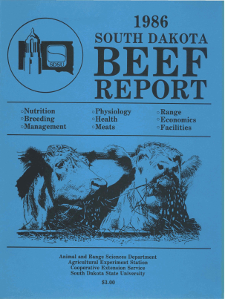
South Dakota Beef Report, 1986
Document Type
Report
Report Number
86-28
Publication Date
1986
Keywords
range improvement, pricklypear control, Picloram
Summary
In a range improvement study, both liquid and pelleted forms of Picloram were effective in controlling pricklypear cactus. Higher rates of chemical hastened control and gave more complete control. At lower rates, cactus was recovering in 1985, the fourth year of study, suggesting that higher rates may be most cost effective. In 1983 noncactus vegetation response was minor. In 1984, "all perennial grass" production increased by more than 50% (312 lb/A) at higher rates of Picloram. Shifts in "cool season" and “warm season" grass components were nonsignificant. In 1985, "cool season grass" was not generally affected by treatments, but "warm season grass" increased at several rates of Picloram. Cactus continued to decrease. Grass utilization by cattle in 1984 increased greatly at higher rates of Picloram. It appears likely that desirable grazable forage can be increased when cactus is decreased. Access to forage appears t o improve substantially as cactus pads collapse. Based only on 1984 livestock grazing utilization estimates and on 1984 increases in perennial grass production, potential reductions in acreages required for livestock grazing ranged from 49 t o 72%. Economic analyses will be conducted a t the end of the study.
Number of Pages
7
Type
text
Format
application/pdf
Language
en
Publisher
South Dakota State University
Rights
Copyright © 1986 South Dakota State University
Recommended Citation
Johnson, J.R.; Tucker, W.L.; Stymiest, C.E.; and Bowker, E.J., "Pricklypear Cactus Control in Western South Dakota" (1986). South Dakota Beef Report, 1986. 29.
https://openprairie.sdstate.edu/sd_beefreport_1986/29

